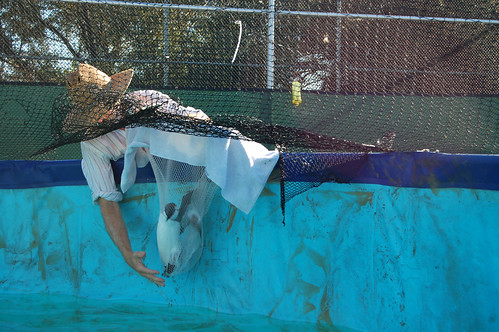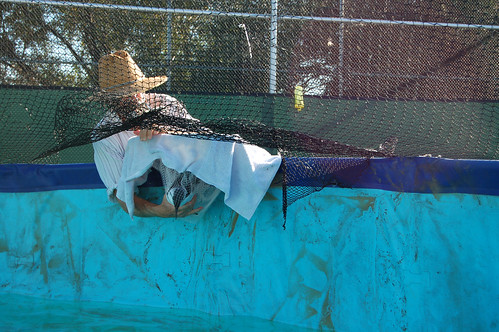A bird in the hand ...
...
So, just how does one move a sea bird out of a swimming pool?
Very, very carefully.
I wanted to share some photographs I took of one of the volunteers at the International Bird Rescue Research Center. I was incredibly impressed by his technique, working with these wild animals. Every move this man made was done with deliberation and care. Assisting him was really an honor.

The birds have to be taken out of their pools, so that they can have medical exams.
I had the job of standing at the opposite side of this pool, and slowly waving a net above the water, in order to "herd" the birds toward the submerged net of the catcher. The trick was to dissuade the birds from swimming out of the reach of the catching net, without completely freaking them out. Birds can literally die of fright.

Once the bird is caught, a towel is placed over the net, so that the bird cannot fly out, and the net is stabilized. The net doesn't tip over, and nobody trips on the net.
Then the bird is inspected, to ascertain if it is tangled in the net in any way.

The catcher then gently places a hand under the bird, lifting it away from the net. The bird is now supported, not dangling into the net.

Gently, the bird is lifted toward the towel.

An interesting fact about birds is that if their eyes are covered, they will become quite docile. So, the towels are used to shield the bird from visual stressors. (You can see the bird's head as a small bulge in the top of the towel.) Covering a bird's head also puts a barrier between beak and handler, which is good for all parties involved.
The birds are firmly and gently wrapped in towels (a sort of Birdie Burrito), to immobilise their wings and legs. A flailing, flapping bird is at risk of injury. By restraining the animal, there is less chance that it may hurt itself.
There's quite an art to wrapping up a bird, so that the towel can be selectively peeled back for examinations of the different parts of the animal.
When I first started doing this, I found the process frightening. What if I hurt the bird? What if it got loose? What if I got bitten? (It hurts. Sea birds are strong.) I think what I'm starting to learn is that you have to put fear aside, and work with deliberation. I don't know if animals can or cannot "smell fear" but I do think that keeping a calm mind in a stressful work environment is always something to strive for.
So, just how does one move a sea bird out of a swimming pool?
Very, very carefully.
I wanted to share some photographs I took of one of the volunteers at the International Bird Rescue Research Center. I was incredibly impressed by his technique, working with these wild animals. Every move this man made was done with deliberation and care. Assisting him was really an honor.

The birds have to be taken out of their pools, so that they can have medical exams.
I had the job of standing at the opposite side of this pool, and slowly waving a net above the water, in order to "herd" the birds toward the submerged net of the catcher. The trick was to dissuade the birds from swimming out of the reach of the catching net, without completely freaking them out. Birds can literally die of fright.

Once the bird is caught, a towel is placed over the net, so that the bird cannot fly out, and the net is stabilized. The net doesn't tip over, and nobody trips on the net.
Then the bird is inspected, to ascertain if it is tangled in the net in any way.

The catcher then gently places a hand under the bird, lifting it away from the net. The bird is now supported, not dangling into the net.

Gently, the bird is lifted toward the towel.

An interesting fact about birds is that if their eyes are covered, they will become quite docile. So, the towels are used to shield the bird from visual stressors. (You can see the bird's head as a small bulge in the top of the towel.) Covering a bird's head also puts a barrier between beak and handler, which is good for all parties involved.
The birds are firmly and gently wrapped in towels (a sort of Birdie Burrito), to immobilise their wings and legs. A flailing, flapping bird is at risk of injury. By restraining the animal, there is less chance that it may hurt itself.
There's quite an art to wrapping up a bird, so that the towel can be selectively peeled back for examinations of the different parts of the animal.
When I first started doing this, I found the process frightening. What if I hurt the bird? What if it got loose? What if I got bitten? (It hurts. Sea birds are strong.) I think what I'm starting to learn is that you have to put fear aside, and work with deliberation. I don't know if animals can or cannot "smell fear" but I do think that keeping a calm mind in a stressful work environment is always something to strive for.

Comments
Grinch